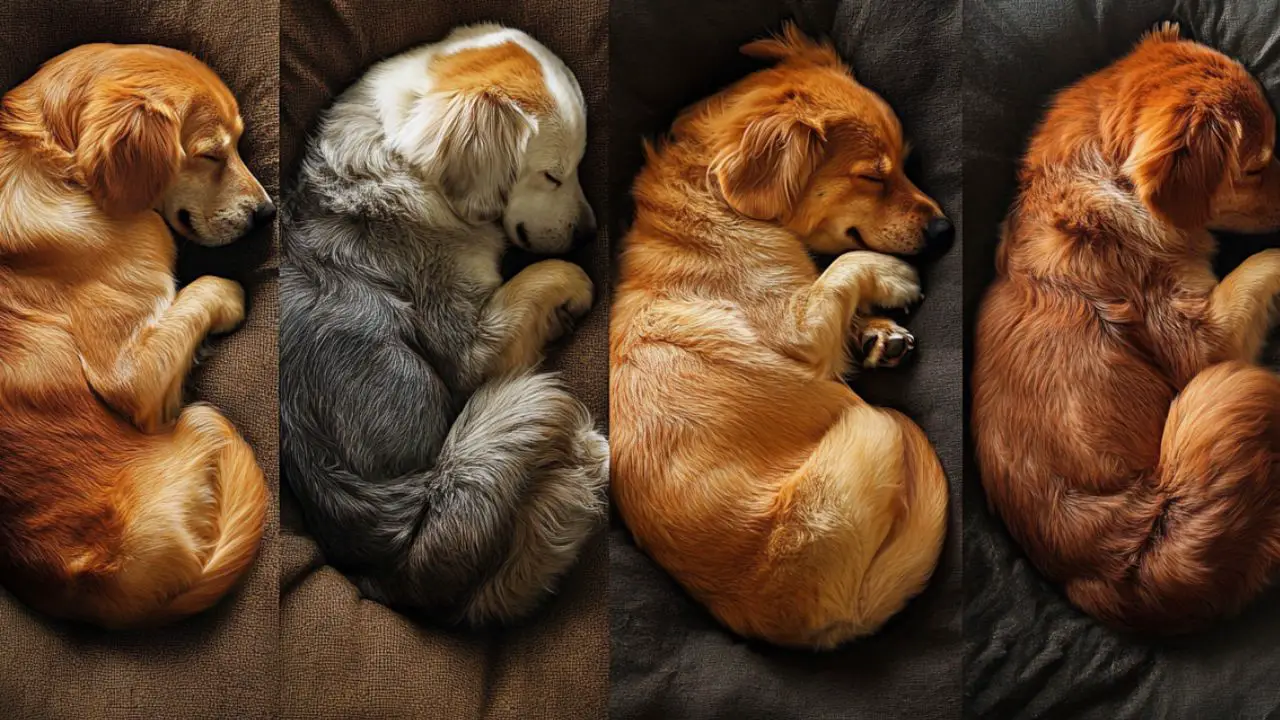Have you ever wondered why your dog sleeps in certain positions?
It turns out that your furry friend’s sleeping habits can offer fascinating insights into their personality and state of mind.
From curled-up balls to sprawled-out poses, each sleeping position tells a unique story about your canine companion.
Let’s explore what these various sleeping positions might reveal about your dog’s personality and feelings.
The Curled-Up Ball
Many dogs sleep curled up in a tight ball, with their paws tucked in and tail wrapped around their body.
This position is reminiscent of how wild dogs and wolves sleep to conserve body heat and protect vital organs.
Dogs who prefer this position may be naturally cautious or feeling a bit vulnerable.
It could also simply mean that your dog is trying to stay warm and cozy.
The Side Sleeper
When a dog sleeps on their side with legs extended, it often indicates a sense of comfort and security.
This position leaves the vital organs exposed, suggesting that your dog feels safe in their environment.
Side sleepers are often easy-going, relaxed, and have a strong bond with their family.
If your dog frequently sleeps in this position, it’s a good sign that they feel at home and trust their surroundings.
The Superman Pose
Some dogs sleep on their stomach with all four legs stretched out, resembling a flying superhero.
This adorable position is often seen in puppies and high-energy dogs.
It allows them to jump up quickly and be ready for action at a moment’s notice.
Dogs who sleep this way are likely playful, energetic, and always up for an adventure.
The Back Sleeper
When a dog sleeps on their back with paws up in the air, it’s both amusing and revealing.
This position leaves the dog completely exposed, indicating ultimate trust and comfort in their environment.
Back sleepers are often confident, easy-going, and enjoy a good belly rub.
This position also helps dogs cool off, so you might see it more often on warm days.
The Donut
Similar to the curled-up ball, but with the dog’s nose tucked into their hind legs, forming a perfect circle.
This position is excellent for conserving heat and might indicate that your dog is a bit chilly.
Dogs who prefer the donut position may be naturally protective or feeling a need for comfort.
It’s also common in newly adopted dogs as they adjust to their new environment.
The Cuddler
Some dogs love to sleep cuddled up next to their owners or other pets.
This behavior indicates a strong bond and a desire for closeness and affection.
Cuddlers are often loving, loyal, and may experience some separation anxiety when apart from their loved ones.
If your dog seeks physical contact during sleep, it’s a sign of their deep attachment to you.
The Burrower
Dogs who like to burrow under blankets or pillows are tapping into their denning instinct.
This behavior can indicate a desire for security, warmth, or simply a love of cozy spaces.
Burrowers are often affectionate and may seek comfort from their owners during stressful situations.
Breeds with a history of den dwelling, like dachshunds, are particularly prone to this sleeping style.
The Belly Flop
This position involves the dog sleeping on their stomach with hind legs stretched back and front paws tucked under.
It allows the dog to cool off while still being ready to spring into action if needed.
Dogs who sleep in this position are often alert, energetic, and ready for whatever comes next.
You might see this position more in younger dogs or those with a vigilant nature.
The Leg Kicker
Have you noticed your dog’s legs twitching or ‘running’ while they sleep?
This is perfectly normal and often happens during the REM stage of sleep when dogs may be dreaming.
Leg kickers are likely active, playful dogs who enjoy physical activities even in their sleep.
This behavior doesn’t necessarily indicate a specific personality trait but shows your dog is deeply relaxed.
The Contortionist
Some dogs sleep in positions that seem impossibly twisted or uncomfortable to human eyes.
These unusual positions often indicate a dog who is deeply relaxed and comfortable in their environment.
Contortionist sleepers are typically flexible, both physically and in temperament.
They may be adaptable dogs who can make themselves comfortable in various situations.
Conclusion
While these interpretations can offer fun insights into your dog’s personality, it’s important to remember that each dog is unique.
A dog’s sleeping position can be influenced by factors like temperature, comfort, and recent activities.
Observing your dog’s sleep habits, along with their waking behavior, can help you understand their needs and feelings better.
By paying attention to these subtle cues, you can strengthen your bond with your furry friend and ensure they feel safe and loved.
Share this article on Facebook to help fellow dog owners understand their furry friends better through their sleeping habits!
SHARE now with your friends!
- Hero Farm Dog Survives Epic Battle with Coyote Pack - December 9, 2024
- The 10-Minute Bedtime Routine That Changed My Dog’s Sleep Forever - November 29, 2024
- Creating a Safe Space for Nervous Pets: Your Guide to Pet-Friendly Havens - November 25, 2024

